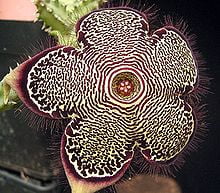Edithcolea

Edithcolea is a monotypic genus with a single species Edithcolea grandis (Persian carpet flower). Once classified in the family Asclepiadaceae, it is now in the subfamily Asclepiadoideae of the dogbane family Apocynaceae. It is native to Africa and to the Arabian Peninsula.[1]
The genus is named after Edith Cole (1859–1940). She collected the type material for this plant with Lort Philips in 1895, during a botanical expedition (1894–1895) led by Ethelbert Edward Lort Phillips (1857-1944) from Berbera to the Golis mountains in Somaliland.[2]
Edithcolea grandis is a succulent plant with leafless richly branched perennial and decumbent stems with a diameter of 2 to 4 cm and up to 30 cm in length (ref prota, ref Field 80). The glabrous stems are 4 or 5 angled and armed with regularly placed hard and acute spinelike teeth or tubercules. The base color of the plant varies from green to red with brownish spots.
The bisexual flowers are 8 to 13 cm in diameter and are formed near the apex of the branches. The flower consists of an outer corolla with 5 corolla lobes (petals), which are fused halfway to the center and a relatively small inner corolla. The outside or back side of the flower is yellow to green. The inside consist of a pale yellow base color with a purple-reddish pattern of spots at the outside that gradually become smaller near the inner corona, which has itself has concentric reddish lines. Long purple hairs are present at the border of the brim of the outer corolla lobes. The flower is at times described as the Persian carpet flower. The carrion-like smell of the flowers attracts flies and other insects for pollination.
